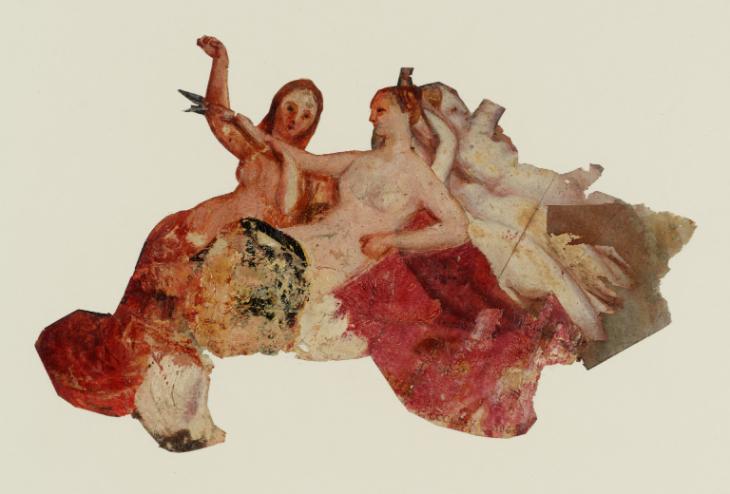Joseph Mallord William Turner A Group of Partly Draped Female Figures, Possibly the Fates from 'The Golden Bough' ?1834
Joseph Mallord William Turner,
A Group of Partly Draped Female Figures, Possibly the Fates from 'The Golden Bough'
?1834
Joseph Mallord William Turner 1775–1851
A Group of Partly Draped Female Figures, Possibly the Fates from ‘The Golden Bough’ ?1834
D36262
Turner Bequest CCCLXIV 395
Turner Bequest CCCLXIV 395
Oil on paper, 85 x 147 mm
Stamped in black ‘CCCLXIV – 395’ bottom right
Stamped in black ‘CCCLXIV – 395’ bottom right
Accepted by the nation as part of the Turner Bequest 1856
References
1830
A.J. Finberg, A Complete Inventory of the Drawings of the Turner Bequest, London 1909, vol.II, p.1209, CCCLXIV 395, as ‘Group of female figures’, after c.1830.
1974
John Gage, ‘Turner and Stourhead: The Making of a Classicist?’, Art Quarterly, vol.37, no.1, Spring 1974, pp.74, 86, pl.17, as ‘The Fates’, 1834.
1984
Martin Butlin and Evelyn Joll, The Paintings of J.M.W. Turner, revised ed., New Haven and London 1984, p.205 under no.355.
This unusual survival is in oils on what Finberg described as ‘tracing paper’.1 It shows a carefully finished group of reclining women, among and partly covered by red and black draperies, trimmed to the edges of the figures. Two on the left raise their arms in graceful gestures; the grouping to the right is less legible, with at least three reclining nudes, two of whom face each other while a third looks up to the right, again gesturing with her arm, albeit in this case truncated above the elbow.
Although close examination suggests five figures, the third and fourth are relatively inconspicuous, and John Gage has proposed that the group represents ‘the three Fates’, which had been ‘apparently drawn in a sketchbook in the life class of the Academy, cut out, and glued on the canvas’ of Turner’s mythological painting The Golden Bough, which he exhibited at the Royal Academy in 1834 (Tate N00371).2 This would account for the anecdote recounted by Gage, that when the painting was subsequently owned by Robert Vernon ‘this paper began to peel, and the artist was called in to make a repair. He removed the paper and kept it, repainting the group on the canvas ... with only two figures facing away ... and with no attributes to identify them’.3 Gage has compared them with the Fates seated and reclining in the foreground of Turner’s large Vision of Medea, exhibited during his stay in Rome in 1828 and again at the Royal Academy in 1831 (Tate N00513).4
‘I remember now. Why, the figure is merely a piece of paper cut out of my pocket-book;’ and he explained that when the picture was nearly finished he determined to introduce the figure, and with that intention he went one night to the life school. It was the study there made which, having put on his picture, not only passed through the Exhibition, but remained there for some five or six years after the picture was in Mr. Vernon’s possession.7
The fact that the present work’s support comprises two sheets pasted together perhaps makes the life class anecdote less likely, although the essence of the episode is presumably true, and this fragment may be the item in question, or perhaps a temporary compositional device use in the planning of a similar subject. Compare the story of the silhouetted paper dog applied by another artist or Turner himself and then incorporated in the painting Mortlake Terrace, the Seat of William Moffatt, Esq. Summer’s Evening, shown at the Royal Academy in 1827 (National Gallery of Art, Washington, DC).8
Tate D36263 (Turner Bequest CCCLXIV 396) is another small painting on paper of a group of elegant nudes.
Technical notes:
The work, trimmed to the outlines of the figures as noted above, is on two sheets pasted together, with the edge of a thicker sheet on the right running diagonally down to the right from where the outstretched arm of the central figure meets the hair of the left-hand figure. The more delicate section has been reinforced with modern tissue paper on the verso. The surface is somewhat distressed, particularly in the draperies of the lower half.
Verso:
Blank; inscribed in red ink ‘ccclxiv | 395’ left of centre; stamped in black with Turner Bequest monogram over ‘ccclxiv | 395’ right of centre.
Matthew Imms
September 2016
How to cite
Matthew Imms, ‘A Group of Partly Draped Female Figures, Possibly the Fates from ‘The Golden Bough’ ?1834 by Joseph Mallord William Turner’, catalogue entry, September 2016, in David Blayney Brown (ed.), J.M.W. Turner: Sketchbooks, Drawings and Watercolours, Tate Research Publication, February 2017, https://www

